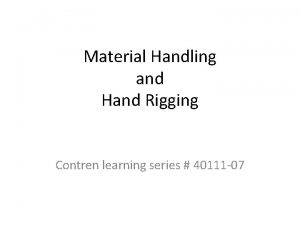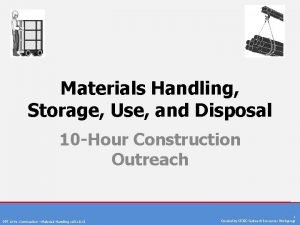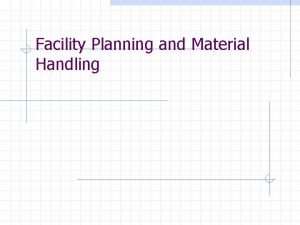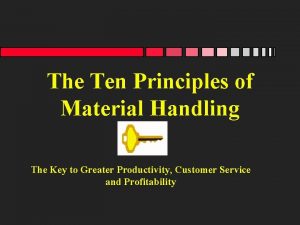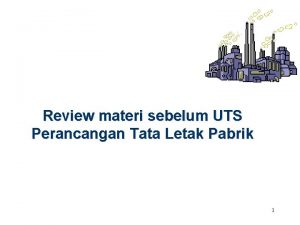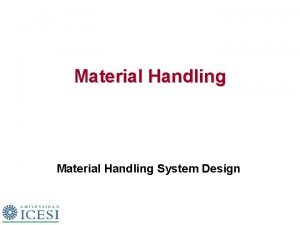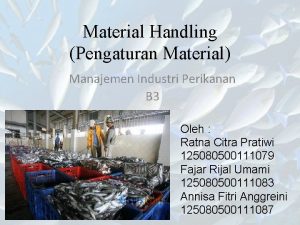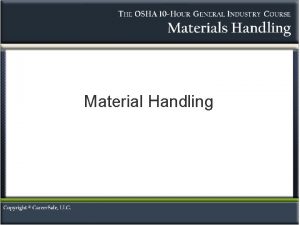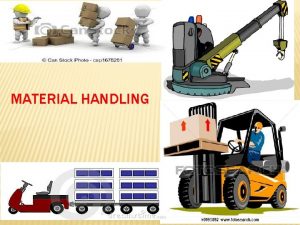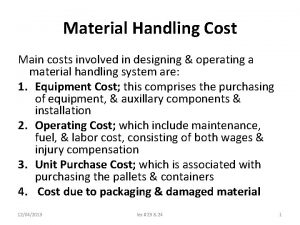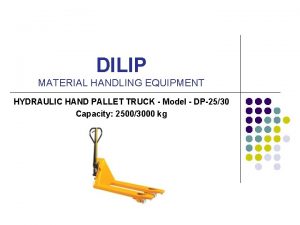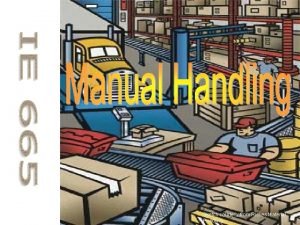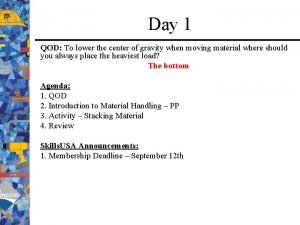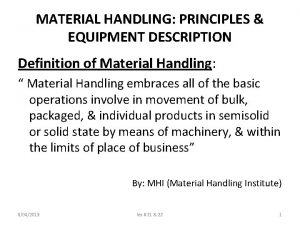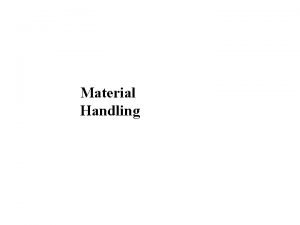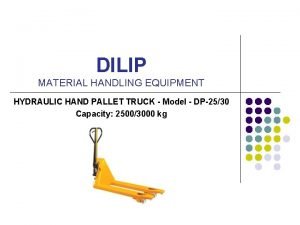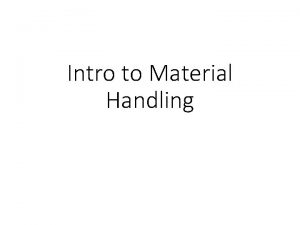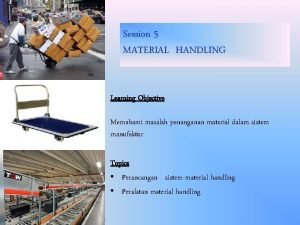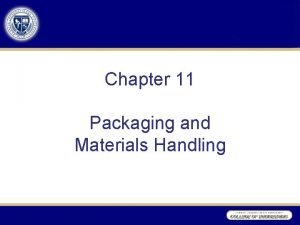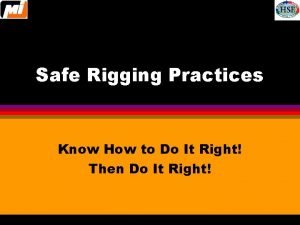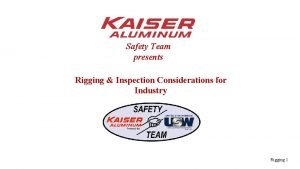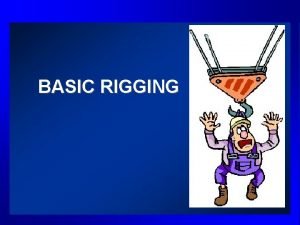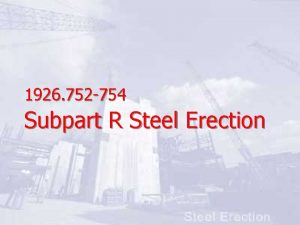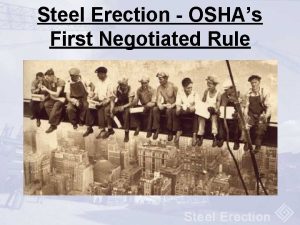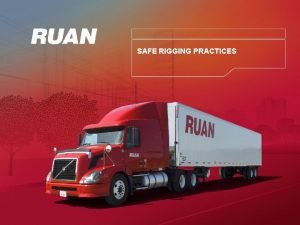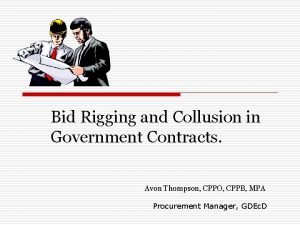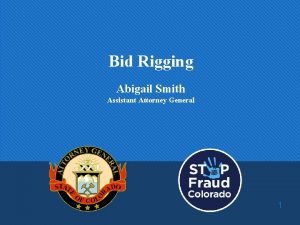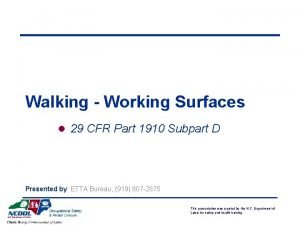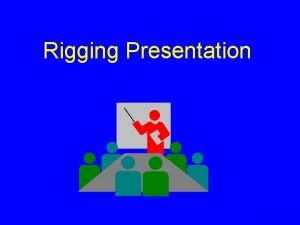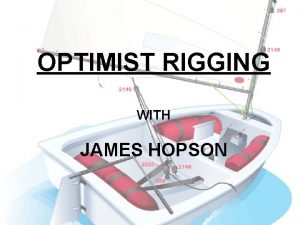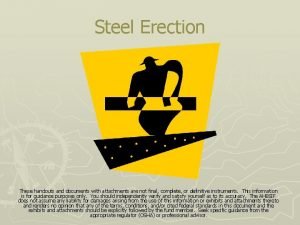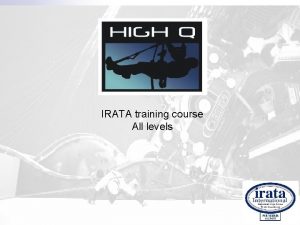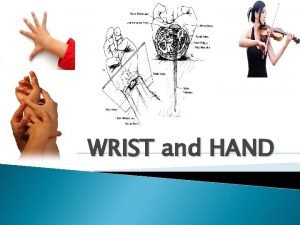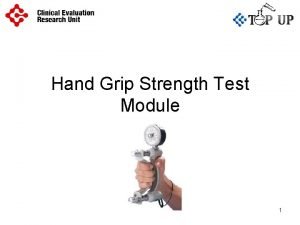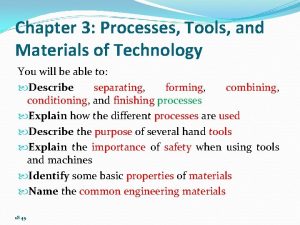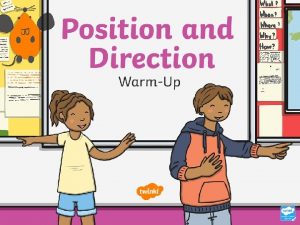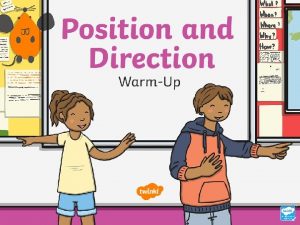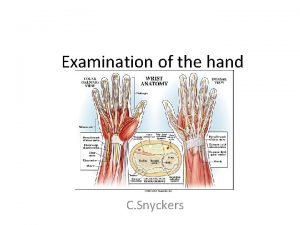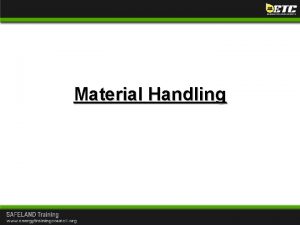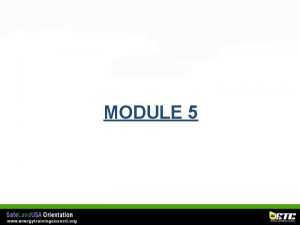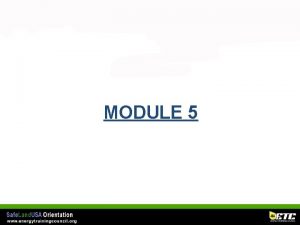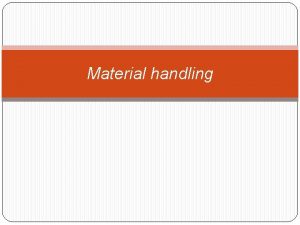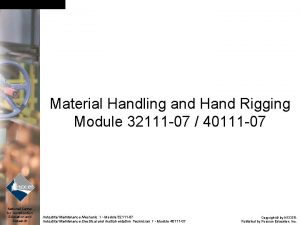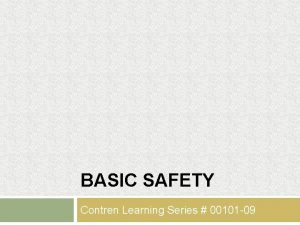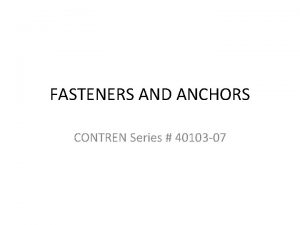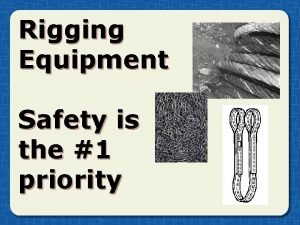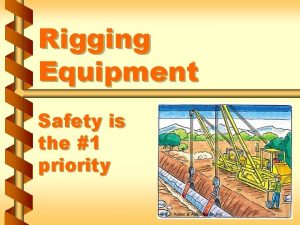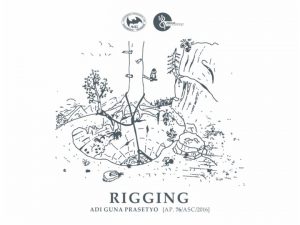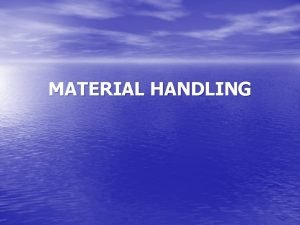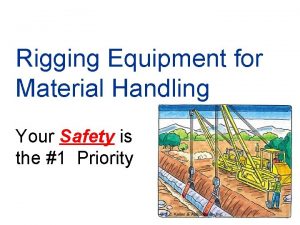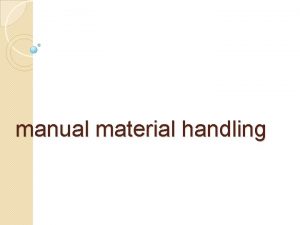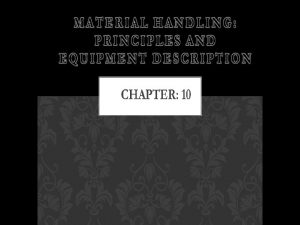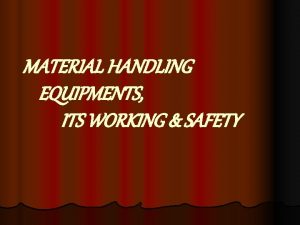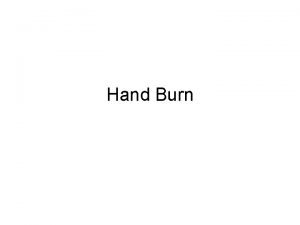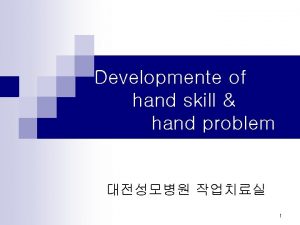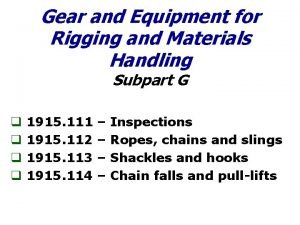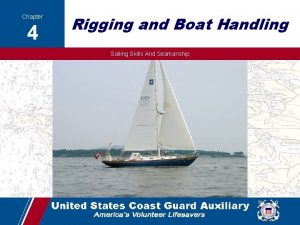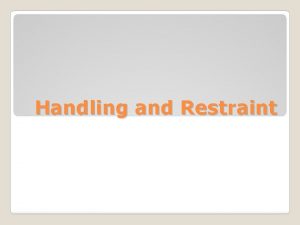Material Handling and Hand Rigging Contren learning series
































































- Slides: 64

Material Handling and Hand Rigging Contren learning series # 40111 -07

1. 0. 0 Introduction • Moving and placing heavy objects is a frequent occurrence in the industrial maintenance profession. • Everyone in this profession needs a knowledge of how to place rigging on a load to safely lift, move, and sit heavy objects. • Everyone will not be the crane operator, but everyone must know how to signal the operator.

2. 0. 0 Rigging Hardware • Only hardware designed for lifting should be used. • • • We will discuss: Hooks Shackles Eyebolts Lifting Lugs Turnbuckles Beam Clamps Plate Clamps Rigging Plates and Links Spreader and Equalizer Beams

2. 1. 0 Hooks • Used to attach to a sling or load. • Always inspect hook before use. • Replace if: – Throat is opened 15% over the original width. – Body is twisted 10 degrees from original plane.

2. 2. 0 Shackles (Clevis) • Used to attach an item to a load or to attach slings or wire ropes together. • Important safety information: – – The shackle pin (not the body) must always be hung on the hook. Pin wear of 10% or more must be replaced. Shackles pulled at an angle has reduced capacity. Never use a shackle in a manner that allows the pin to be rolled under a load.

2. 3. 0 Eyebolts • Attached to heavy equipment to give connection points for lifting. • Shoulder-less eyebolts can only be used for vertical lifting. • Use shoulder eyebolts for angled lifting connections. • Position the ring so that the lifting force is applied to the ring.

2. 4. 0 Lifting Lugs • Custom-built for a specific machine for proper lifting. • May be welded, bolted, or pinned to the machine.

2. 5. 0 Turnbuckles • Used to adjust the length of rigging connections. • Typical ends: Eye, jaw, hook. – Hook ends have less load capacity than others. • Important safety information: – – – Do not weld on a turnbuckle. Only one turnbuckle per leg. Do not use jam nuts (unless supplied by factory). Do not over-tighten. Use correct wrench size only. Not for angular loading unless factory-specified.

2. 6. 0 Beam Clamps • Used to connect lifting devices to structural beams so they can be lifted and positioned. • Two clamps may be used as long as the bridle sling angle does not exceed 25 degrees from vertical. • Replace clamp if jaws open more than 15% of original.

2. 7. 0 Plate Clamps • Used to grip structural plate steel for attachment to lifting devises. • Screw plate clamps are considered to be the safer than the cam plate clamps. • Grip and lift only one sheet at a time. • Replace if evidence of any wear or deformation to body or teeth is seen.

2. 8. 0 Rigging Plates and Links • Plates and links that are custom built for a specific component to be lifted.

2. 9. 0 Spreader and Equalizer Beams • Used to support long loads during the lifting operation. • Tested at 125% of the rated capacity.

3. 0. 0 Slings • • Common Sling Types: Wire Rope Synthetic Web and Round Metal Mesh

3. 1. 0 Sling Capacity • Capacity depends on: • Sling material and type • Hitch configuration and quality

3. 2. 0 Sling Care and Storage • Store slings on a rack off the ground. • Do not drive or walk over slings. • Thoroughly inspect slings before each use.

3. 2. 1 Wire Rope Slings • Inspect for: – – – – Broken wires Diameter reduction Heat damage Corrosion Damaged ends and fittings Rope distortion Core protrusion Unlaying of a splice ------D------ - --d • Discard if wear exceeds one-third of original diameter. • The D/d ratio affects the capacity of wire rope slings. • There are charts that give you the efficiency based on D/d.

3. 2. 2 Synthetic Web and Round Slings • Inspect for: – Chemical burns – Melting – Holes, cuts tears, snags – Broken stitches in splices – Abrasion – Knots – Damaged fittings – Missing or illegible tag

3. 2. 3 Metal Mesh Slings • Inspect for: – Broken weld joints – Broken wires – wire diameter reduction • Discard if: • Wire diameter reduction is • 25% - abrasion • 15% - corrosion – 10% increase in choker slot – 10% increase in eye openings – 15% reduction in web cross-section

3. 3. 0 Chain Slings • Recommended for: – Rough objects (ie: castings) – High temperatures • Not recommended for routine lifting • • A chain link is a single bar of steel. If one link breaks, the load falls, Usually without warning. If any portion is worn 15%, remove from service. • Chains must be annealed every 1 -2 years. – After being annealed 6 times, destroy chain. • Use only Grade 8, or higher, chain.

3. 3. 1 Chain Sling Storage • Store chains on a rack off the ground. • Do not drive or walk over chains. • Thoroughly inspect chains before each use. • • Lubrication of chains can be dangerous. Slippery when handling. Lubricates attract dust, causing abrasion. Sometimes lubrication is necessary for storage in exposed environments.

3. 3. 2 Chain Sling Care and Inspection • Inspect before each use. • Annual inspection (replace if: ) – Wear – 15%, or more, anywhere – Stretch – 5% longer than original – Links – twisted, bent, cut, gouged, or nicked – Cracks – in any part of chain – Link Welds – any deformation – End Fittings – stretch, wear, twist, cut, opening – Capacity Tag – missing or illegible

4. 0. 0 Tag Lines • Typically are natural fiber or synthetic rope • Hand- held to keep load from swinging or twisting

5. 0. 0 Block and Tackle • Basic lifting device used for light loads • Capacity of simple b&t is equal to the load line (tackle) • Capacity of compound b&t is higher due to more sheaves; thus, multiple load lines Compound Simple

6. 0. 0 Chain Hoists • • Lifting device for lifting light loads Sometimes referred to as chain falls For straight vertical lifting only Never wrap the chain around the load – Always attach a choker to the chain

6. 1. 0 Spur-Geared Chain Hoists • • Lifting device for lifting light loads For straight vertical lifting only Most efficient type of manual hoist Most commonly used

6. 2. 0 Electric Chain Hoists • Works just like a spur-gear hoist • Except than an electric motor is used instead of a pull chain

6. 3. 0 Care of Chain Hoists • Inspect before each use. – Check for adequate capacity. – Inspect load chain and hook. – Inspect sheaves. – Check for proper lubrication. – Assure that hoist is securely hung.

7. 0. 0 Ratchet-Lever Hoists and Come-Alongs • Used for short pulls. • Ratchet-Lever Hoist Fast Wind Handle For spooling of chain – Uses a chain for load suspension – Vertical lifts only. – Not the same as a chain hoist. • Come-Alongs – Uses a cable for load handling – Horizontal pulling only Ratchet Handle For load handling

8. 0. 0 Jacks • Used to raise or lower equipment. • Short movements with good control. • Three types: – Ratchet jack – Screw jack – Hydraulic jack

8. 1. 0 Ratchet Jacks • • Raises and lowers loads under 25 tons Uses the lever-and-fulcrum principle Raises or lowers one notch at a time A pawl locks the load between lift strokes

8. 2. 0 Screw Jacks • Can raise or lower loads heavier than the ratchet jack • Uses the screw-and-nut principle • Turning the screw raises or lowers the load

8. 3. 0 Hydraulic Jacks • Most useful general purpose jack • Uses hydraulic pressure • Slow, but very precise movements

8. 4. 0 Inspecting and Using Jacks • • Inspect before each use Use the proper jack handle (no extensions) Remove the jack handle when not using Place on solid footing Assure vertical lifting Block and crib load as it is raised or lowered Never exceed jack capacity

9. 0. 0 Tuggers • • Electric or pneumatic wenches Used for lifting, lowering, and pulling Assure adequate capacity Assure secure anchoring

10. 0. 0 Cranes • Cranes are a valuable resource for handling heavy equipment and structural components. • Overhead cranes • Gantry cranes • Mobile cranes

Overhead Girder Crane

Gantry Crane

Jib Crane

Mobile Crane

Job-Site Safety ?

Crane Operations

10. 1. 0 Verbal Modes of Communication • Type of communication depends on the requirements of the situation: • Portable radio (walkie-talkie) • Frequency noise or crowding can be disruptive • Background noise can interfere

10. 2. 0 Non-Verbal Modes of Communication • Flags and whistles have been used. • Hand signals are the most common form of crane communication. • ASME B 30. 5 Consensus Standard of Hand Signals

10. 2. 0 Non-Verbal Modes of Communication • If a mobile crane is being moved without the direction of a rigger, the operator must use the crane’s horn to signal: • STOP – one (1) audible signal • FORWARD – two (2) audible signals • REVERSE – three (3) audible signals

11. 0. 0 General Rigging Safety • The rigger must be aware of all hazards, including those that are unavoidable: • Weather – wind, rain, snow, etc. • Slippery surfaces • Unguarded areas (adjacent to worksite) • Remember that most accidents result from human error.

11. 1. 0 Personal Protection • • • Hard hats Safety glasses Ear plugs Gloves Steel toe boots Barricades

11. 2. 0 Equipment and Supervision • Employer is responsible for ensuring that all hoisting equipment is operated by experienced and trained personnel. • As a rigger, you are responsible for selecting the correct rigging and lifting equipment, using it correctly, and directing the crane movements safely and effectively.

11. 3. 0 Basic Rigging Precautions Determine the weight of the load and rigging. Verify load limits for hoisting equipment. Examine all equipment and rigging. Discard, and report, all defective equipment. Stay weather-conscience; be prepared to stop. Be alert for factors that can reduce equipment capacity. • Keep loads plumb if at all possible. • Avoid sudden snatching, swinging, and stopping. • Avoid rapid acceleration and deceleration. • • •

11. 4. 0 Barricades • Always use barricades to isolate the swing area of a lift. • Be sure you understand your company’s barricading policy before you start.

11. 5. 0 Load-Handling Safety • As a rigger, you are the ‘eyes’ of the crane operator. • Be confident of the full path of the lift before you start. • Watch area outside the swing. • Watch the path of the rear (counterweight) area of the crane.

12. 0. 0 Working Around Power Lines • Sometimes, it is necessary to lift close to energized power lines (proximity work). • Charts are available stating how close you can get to a power line of a given voltage. • 0 -50 k. V • 350 -500 k. V 10 ft 25 ft

Look Up and Live

13. 0. 0 Site Hazards and Restrictions • Know the site before you start. • There are many site hazards: • Underground utilities – Water, gas, oil, electrical, telephone, sewer, drainage, tanks. • In the air: – Electrical and telephone poles, wires, and towers. • On the ground: – Structures. – Soft ground that will not support the weight.

14. 0. 0 Emergency Response • Learn your company’s emergency response procedures before you start. • React quickly. • React correctly.

14. 1. 0 Fire • If at all possible, lower the load and secure the crane. • In either case, evacuate the area. • Call 911. • Attack fire only if feasible. • Judgment is crucial in evaluating proper responses to fire emergencies. Be sure someone on site is capable.

14. 2. 0 Malfunctions During Lifting Operations • Mechanical malfunctions can be serious. • A failure could cause the crane to tip over, a boom to collapse, etc. • These are unlikely but be alert for them. • If a malfunction does occur, try to lower the load and secure the crane. • Tag the crane out of service.

14. 3. 0 Hazardous Weather • Be aware of changing weather conditions. • Be prepared to cease operations and take shelter if hazardous weather is approaching. • Lightning sensors are used in some areas to detect lightning strikes up to 20 miles away.

14. 3. 1 High Winds and Lightning • High winds and lightning are the two most dangerous weather hazards to crane operations. • Because of the boom and load in the air, high winds can tip over a crane. • Because the boom is tall and made of metal, it attracts electrical energy.

15. 0. 0 Using Cranes to Lift Personnel • OSHA 29 CFR 1926. 550 regulations: • Although not prohibited, personnel lifting with a crane is discouraged and only used when no other means is suitable.

15. 1. 0 Personnel Platform Loading

15. 2. 0 Personnel Platform Rigging • All wire-rope bridle legs must be attached with shackles or master links. • All hooks must have safety latches and be closed. • Safety factor: rigging must be rated at 5 times the intended loading. • Personnel, equipment, and materials necessary to perform work is the only items permitted on the platform.

16. 0. 0 Lift Planning • Some companies require a written lift plan. • Plan includes information on crane, load, and rigging. • Even without a written plan; the crane, load, and rigging must be inspected and the entire lift must be planned before you start.

16. 1. 0 Lift Plan Data • A tremendous amount of data is required to complete a Lift Plan. • Be sure that all the information is recorded.

17. 0. 0 Crane Component Terminology • It is important that you know the names of the basic components of a crane. • A complicated lift or an emergency may require you to swiftly give information or warnings about a particular area of the crane. This would not be the time to describe what the component looks like.
 Equalizer beam rigging
Equalizer beam rigging Potential hazards
Potential hazards Material handling and facilities planning
Material handling and facilities planning Principles of material handling
Principles of material handling Pertanyaan tentang strategi layout
Pertanyaan tentang strategi layout Unit load handling systems
Unit load handling systems Tujuan material handling
Tujuan material handling Material handling introduction
Material handling introduction Introduction of material handling
Introduction of material handling Material handling cost
Material handling cost Dilip material handling equipment
Dilip material handling equipment Riekes material handling
Riekes material handling Tines
Tines Material handling efficiency
Material handling efficiency Material handling definition
Material handling definition Material handling objectives
Material handling objectives Dilip material handling equipment
Dilip material handling equipment Space robotics ppt
Space robotics ppt Tines
Tines Prinsip material handling
Prinsip material handling Packing learning objectives
Packing learning objectives Safe rigging practices
Safe rigging practices Whats a quarter past 7
Whats a quarter past 7 The hour hand
The hour hand Geometric symbol
Geometric symbol Non material culture
Non material culture Whats cultural lag
Whats cultural lag Example of material culture
Example of material culture What are these materials available at home
What are these materials available at home Cuadro comparativo e-learning m-learning b-learning
Cuadro comparativo e-learning m-learning b-learning Series aiding and series opposing
Series aiding and series opposing Bid rigging vs price fixing
Bid rigging vs price fixing Rigging sling angles
Rigging sling angles Rigging an experiment meaning
Rigging an experiment meaning Tag line rigging
Tag line rigging 1926 subpart r
1926 subpart r Multiple lift rigging assembly
Multiple lift rigging assembly Safe rigging practices
Safe rigging practices Maya skirt rigging
Maya skirt rigging Bid rigging example
Bid rigging example Al smith rigging
Al smith rigging 29 cfr 1910
29 cfr 1910 Wire rope nomenclature
Wire rope nomenclature Optimist tuning guide
Optimist tuning guide Examples of bid rigging
Examples of bid rigging Bid rigging
Bid rigging Christmas treeing rigging
Christmas treeing rigging Irata training
Irata training Flexor digitorum superficialis test
Flexor digitorum superficialis test Mother father sister brother hand in hand with one another
Mother father sister brother hand in hand with one another Left hand right hand chart example
Left hand right hand chart example Im abendrot eichendorff wikipedia
Im abendrot eichendorff wikipedia Hand in hand module 1
Hand in hand module 1 Technology tools and equipment names
Technology tools and equipment names You put your left hand in
You put your left hand in Father mother sister brother hand in hand with one another
Father mother sister brother hand in hand with one another Right hand in the air left hand in the air
Right hand in the air left hand in the air Ape hand vs hand of benediction
Ape hand vs hand of benediction What is the push and pull method
What is the push and pull method Drop hand claw hand
Drop hand claw hand Hand by hand
Hand by hand Voorstellen aan de hand van je hand
Voorstellen aan de hand van je hand Rsq formula in standard costing
Rsq formula in standard costing Material series 1b general catalystfeldmanforbes
Material series 1b general catalystfeldmanforbes Maclaurin series vs taylor series
Maclaurin series vs taylor series
